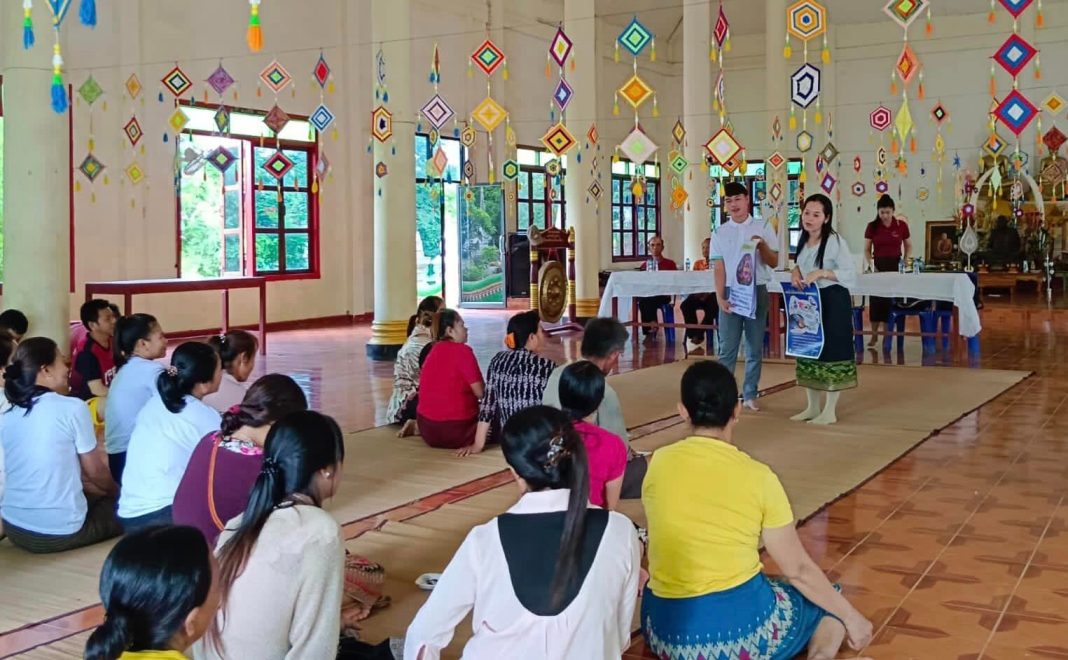Op-Ed by Patricia Ongpin, UNAIDS Country Director for Cambodia, Lao PDR, and Malaysia, Dr Panina Phoumsavanh, Director of Center for HIV, AIDS and STI (CHAS), Phanthamith Seangpanya, Director of Association of People Living with HIV/AIDS (APL+)
Communities are the drivers of progress and innovation in the national HIV response. They connect people to public health services, build trust, innovate, monitor the implementation of policies and services, and hold service providers accountable. That’s why communities are at the center of World AIDS Day commemorations this year.
Achievements made through community leadership
Through well-organized community mobilization, the Association of People Living with HIV/AIDS (APL+) in Lao PDR engaged with nearly 740,000 individuals in awareness-raising campaigns in local communities and on social media platforms to promote equality and a stigma-free environment. This has resulted in improved access to essential services for people living with HIV and populations at risk, indicating that letting communities lead builds stronger and healthier societies.
However, communities are not fully leveraged for their expertise and leadership. Community-led responses are under-recognized and under-resourced, leaving local initiatives struggling to continue operating and expanding into areas and populations that most need their support. This also threatens to lose the gains made in the national HIV response over the last decade and jeopardizes the sustained impact of the HIV program for years to come.
Globally, funding for communities has fallen from 31 percent in 2012 to 20 percent in 2021. These funding shortages, policy and regulatory hurdles, capacity constraints, and challenges faced by civil society and marginalized communities are some of the major obstacles to progress in HIV prevention, treatment, and care services.
It is in everyone’s interest to fully fund and empower community-led organizations. Removing the many obstacles they face will enable communities to exercise their role and leadership towards realizing the end of AIDS in Laos.
A new UNAIDS report, Let Communities Lead, sets out the facts and figures that demonstrate communities’ impact and shares how progress is being driven by society members through case studies from across the world and through guest essays by nine pioneering community leaders.
As the report notes, there is a need not only to recognize the contribution that communities make but also to pull down the barriers that stand in their way.
This implies that community leadership should be central to all HIV plans and programs, encompassing their formulation, budgeting, implementation, monitoring, and evaluation. Also, communities require consistent and ample funding to expand their services, ensuring fair compensation for their contributors. Lastly, obstacles hindering community leadership must be eliminated, necessitating a regulatory and legal framework that fosters an enabling environment for communities to operate while safeguarding fundamental rights for all, including gay men and other men who have sex with men, transgender individuals, people who use drugs, and sex workers.
“Nothing About Us Without Us!”
It has been a long-standing principle of the HIV response to bring people living with and affected by HIV to the decision-making table.
Supporting communities in their leadership is not only the right thing to do but also essential for advancing public health.
AIDS is far from over. In Lao PDR, it is estimated that at least one young adult becomes infected with HIV every day. Approximately 72 percent of total new HIV infections are among key populations and their sexual partners. Increasing proportion of new HIV infections are among men and boys; they accounted for 68 percent all new HIV infections in 2022. From January to October, the number of people newly diagnosed with HIV was 1,757.
We need to invest more in communities to unleash the full potential of community leadership to address the gaps we still have in the national HIV response. And to sustain community-led responses, we have to encourage a sense of ownership. This motivates communities to invest in a future free of HIV through both pride in protecting themselves and their loved ones and preventing transmission to others.
Every year, the world marks World AIDS Day on 1 December. On this World AIDS Day, we call upon the government, development partners, and civil society organizations to continue to invest in and support the role of community leadership in the national HIV response.
For decades, our synergy with communities, especially people living with HIV and key populations, has strengthened the HIV response, built necessary capacities, and harnessed the power of community advocacy. None of this is possible without political, financial, and technical support.
As we move forward in our path to end AIDS, let us remember the journey, the milestones, and the lessons. And more importantly, let’s recognize that community-led initiatives are not a supplementary effort but an integral part of the solution. We must continue to invest in promoting community-led responses to HIV that drive us closer to a world of healthy lives.
By working hand in hand with communities, we can achieve a future where HIV is no longer a global threat but a historic achievement.



